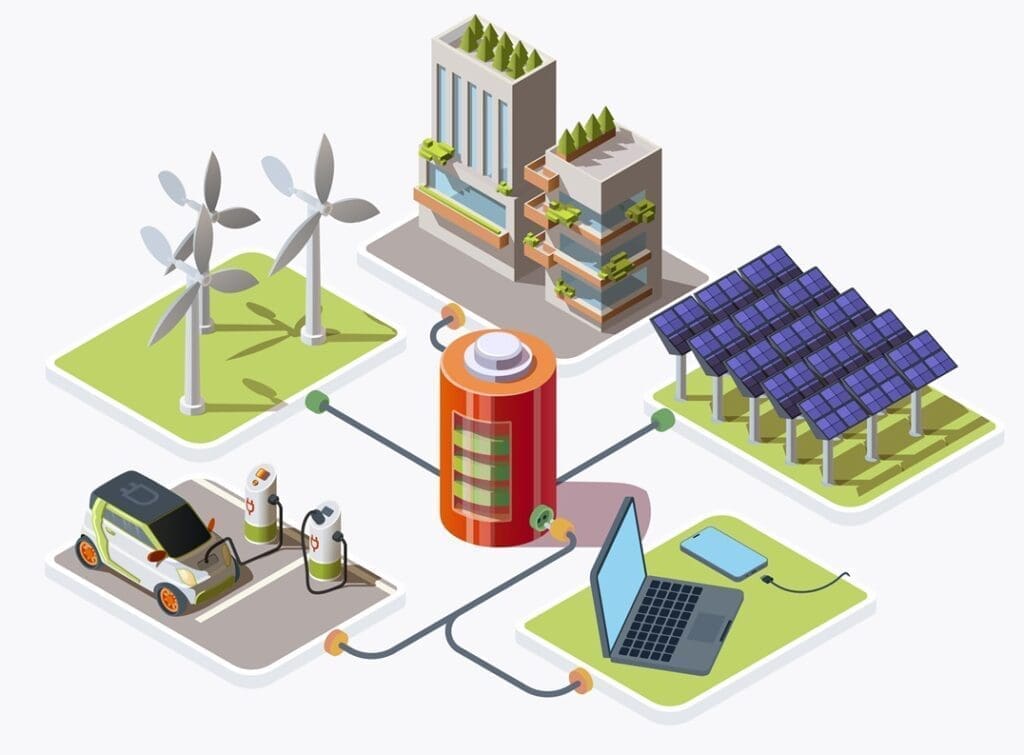Hybrid energy systems – what are hybrid installations?
 Hybrid energy systems
Hybrid energy systems
Hybrid energy systems are one of the solutions for optimising the electricity generation process in the energy sector. What is the principle of their operation? What energy sources do they use? Why are they being created? What are hybrid installations? Read on to learn more on this subject.
Climate change, new environmental regulations, new technological possibilities and the growing demand for electricity mean that the energy sector is constantly on the lookout for new solutions to address these challenges. One approach, already used in practice, is to combine different energy sources to optimise the energy production process. Such a solution, known as hybrid energy systems, is increasingly being used in the context of RES.
Hybrid energy systems – definitions
A definition of hybrid energy systems can be found, for example, in the Act on Renewable Energy Sources. Article 2, which contains definitions, elaborates on the term “hybrid renewable energy sources installation”. According to the provisions of the Act, it is:
“a separate set of facilities described by technical and commercial data, in which the degree of utilisation of the installed electrical capacity during the year is the ratio of MWh of electricity generated per each MW of the connection capacity, connected to the power grid at a single connection point, generating electricity in these facilities exclusively from renewable energy sources differing in type and availability characteristics of the electricity generated, and meeting the following conditions:
- none of the generating facilities has an installed electrical capacity greater than 80% of the total installed electrical capacity of that set
- the power output from the facilities comprising that set to the power grid shall be via a device connecting that set to the power grid and serving to transform the energy so that it meets the conditions necessary for its entry into that grid
- the set shall include an energy storage facility for the storage of electricity from the generating facilities comprising that set, whereby the share of electricity from those facilities fed into the power grid through the energy storage facility in the total volume of electricity fed into the power grid shall be no less than 5% per year, not including electricity taken from the grid.”
Hybrid installations in practice
Analysing the definition quoted above, it can be seen that it refers to RES and thus talks about combining different sources of clean energy, such as photovoltaics and wind turbines or photovoltaics and RES heat pumps. The aim of creating hybrid installations is primarily synergy, whereby the different sources of energy generation complement each other, eliminating or offsetting the disadvantages of individual solutions. The above-mentioned example of photovoltaics and wind power can provide a good illustration of how hybrid installations work. Both systems can be operated simultaneously, and it is also possible to programme them so that the photovoltaics produce more energy in windless periods and the wind turbines support PV when there is less sunlight.
Such solutions offer a wide range of benefits. On the one hand, hybrid photovoltaics are a more reliable and more secure source of energy from the consumer’s perspective – they have a higher generation potential than a single source and enable energy production under varying conditions. On the other hand, it is worth noting the environmental benefits of hybrid installations. Using them makes it possible to reduce dependence on fossil fuels, which contributes to a reduction in greenhouse gas emissions.

Photovoltaic hybrid systems and energy storage
The installation of photovoltaic panels and the construction of a wind turbine alone are not sufficient to create a hybrid installation under the Renewable Energy Sources Act. Other key elements are energy storage systems and connection to the power grid. The role of an energy storage facility is primarily to increase the flexibility of the overall system and to balance the instability of producing energy from renewable sources. Energy storage systems are undergoing a period of rapid development due to increasingly modern and efficient cells and are an important element from the point of view of managing the energy production and distribution process.
Furthermore, an energy storage facility is an important point in the context of integrating a hybrid system with the power grid. Although, in practice, any solution using different sources of energy generation can be considered a hybrid system, according to the statutory definition, an off-grid photovoltaic installation combined with another energy source, such as a wind turbine, which only uses batteries and is not connected to the grid, fails to meet the prerequisite to be considered a hybrid RES installation. For this, it is necessary to integrate the installation into the grid via specialised PV transformers, which are devices used in the process of converting the electricity generated by PV panels into a form that can be transmitted to the power grid.
Hybrid energy systems – a summary
The wider use of hybrid solutions is one of the answers to the challenges faced by the energy sector. Hybrid energy systems exploit the potential of a variety of renewable energy sources and – through the use of energy storage facilities and connection to the power grid – provide a solution that is flexible, stable and ensures continuity of supply. Higher efficiency, reduced environmental impact, greater energy independence – these are just a few of the long list of arguments for the further development of hybrid installations.